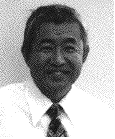Created by Per Nyfelt

He has authored more than 190 publications in a wide range of subjects including psychiatry, psychology, sociology, anthropology, philosophy, cybernetics, architectural design, urban planning, social change, business management, and neuroscience. He has been a consultant to Volvo, Michelin, Monsanto, OECD, NASA, MITI of Japan, USA Department of Commerce, USA Department of Interior, Federal Motors of Indonesia, Government of Ivory Coast, and the City of Baghdad.
In all the fields in which Professor Maruyama has worked, his central interest has been in the heterogeneity of individual perceptual, cognitive, cogitative and epistemological patterns.
This was motivated by some practical problems:A specific example for (a) is the following: When his article article "The second cybernetics" (American Scientist 1963) was published readers immediately understood its quantitative side, i.e. that changes can be amplified in causal loops. However, the more important qualitative side, i.e. that interactive heterogeneity is indispensable, desirable and increasing went unnoticed.
Before its publication in American Scientist, the manuscript was rejected by ten other journals because this qualitative side was not understood by the journal editors. After its publication, it was cited in more than 230 publications , according to Citation Classic but in most cases, the readers still did not even notice the qualitative side. Professor Maruyama realized that this must be due to epistemological rather than intellectual limitations of the readers because the "sub-understanders" included eminent scholars.
An example of (b) is the story referred to by Professor Maruyama in several of his articles where he, while living in Scandinavia between 1955 and 1959 and frequently commuted between Malmö in Sweden and Copenhagen in Denmark, discovered that some Danes found Sweden to be a better epistemological environment for them than Denmark, while at the same time some Swedes found Denmark to be a more compatible epistemological milieu for them.
In the 1950s, the differences between Sweden and Denmark in terms of epistemological environment was as follows:
In the Danish culture, the mail purpose of daily conversation was maintainance of familiar atmosphere and affect relations.
For example, a group of friends often sat together in the same coffee shop, eating the same pastry week after week, telling
the same or similar gossip. Subtle variations were considered interesting. For example, everyone in the group knew that
Mr. X tied his left shoe first, then his right shoe. One day he reversed the sequence. This became big news. Less subtle
informations was avoided because it might disturb the familiar atmosphere. It was impolite to explain things, because such an act
assumed that someone was ignorant. It was also impolite to ask questions on anything beyond immediate personal concern, because the
respondent might not know the answer. It was often considered aggressive to introduce new ideas. One preferred to repeat the same
old jokes. Discussion of politics or economics was taboo, except in marginal enclaves. Safe topics of intellectual conversation
were art, literature and music, on which you could disagree without embarrassment, because people were expected to have different
tastes.
In contrast, in Sweden the purpose of daily conversation was transmission of new information or frank expression of feelings. One preferred to
remain silent unless one had an important message, while in Denmark one had to keep talking. The two countries had almost opposite
epistemological environments and Professor Maruama notices that some individual crossed the border to find their epistemological match, which proved the heterogeneity and transculturality of individual epistemological types (a.k.a. Mindscapes).